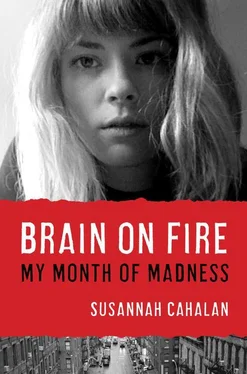My visual working memory was even worse. Dr. Bertisch presented a picture of a shape for a few seconds and then asked me to draw it from memory. No matter how hard I tried, I couldn’t imagine the original shape. Here I was in the first percentile, the most severely impaired.
My ability to conjure up words from memory was also fairly poor. Dr. Bertisch repeated the same style of test that had been done in April, when Dr. Chris Morrison asked me to name fruits and vegetables, but this time Dr. Bertisch gave me a minute each to think of as many f , a , and s words as I could:
F: “Fable, fact, fiction, finger, fat, fantastic, fan, fastidious, fantasy, fart, farm”
A: “Apple, animal, after, able, an, appeal, antiquity, animosity, after, agile.” (Because I had repeated “after” I got only nine.)
S: “Scratch, stomach, shingle, shit, shunt, sex, sing, song, swim, summer, situation, shut”
Overall, I named 32 words in 3 minutes. Though this was a significant improvement from April, when I could name only 5 words in one minute, the average number of responses is 45.
Yet in other tasks, I had made significant progress. My verbal functioning was now “superior,” in the ninety-first percentile. My verbal abstract reasoning, which was tested by using analogies, such as “How are China and Russia related?,” was in the high-average eighty-fifth percentile. And despite difficulties with basic cognitive functions, I was still capable of complex analytical thinking, which surprised Dr. Bertisch. On a test involving pattern recognition, I got everything correct, though it took me longer than normal to do so. I couldn’t draw an octagon from a visual cue card, but I could make complex leaps in logic. Later she would tell me that the way I presented to people did not match up with what seemed to be going on internally. There was a serious disconnect, and I may have actually been more present than I appeared. I felt this divide too. Often, like at the party and the wedding just a few weeks before, I felt as if my “self” was trying to communicate with the outside world but couldn’t break past the broken intermediary, my body.
At the end of our last interview, Dr. Bertisch asked me what I felt were my most pressing problems. “Problems with concentration. With my memory. Finding the right words,” I told her.
This she found reassuring. I had defined exactly what was wrong with me. Often those with neurological issues cannot readily identify what is the matter. 47They don’t have the self-awareness to understand that they are ill. Paradoxically my ability to recognize my own weaknesses was a strength.
This explained why social situations were so rough on me: I was aware of how slow and strange I appeared to those around me, especially people who had known me before my illness. I expressed this insecurity to Dr. Bertisch, admitting that I often felt depressed and anxious in groups. She suggested individual and group cognitive rehabilitation, individual psychotherapy to address symptoms of depression and anxiety, and a young adult group.
In the end, though, I was so unsure of myself that I did none of it. In retrospect, this was a big mistake: there is a window of spontaneous healing in the brain after injury or illness, and it’s best to jump at any opportunity for faster revitalization. Though it’s unclear what role cognitive rehabilitation plays in the recovery from this disease, I would have likely mended more quickly had I done it. But these sessions only highlighted my inner disunity, and I was loath to continue. I never returned for a follow-up. As it was, it took me a year to even decide to track Dr. Bertisch down and get the results of this one group of tests. I didn’t yet have the nerve to face how bad off I really was.
Icouldn’t help but consider another hospital stay as a step backward in the march toward recovery, so when Dr. Najjar called my mother in late May to say that I needed to return to the hospital for a second round of IVIG treatment, I was despondent. I shuddered to think of the harsh lights of the hospital room, the constant interruptions of the nursing staff, and those awful preheated dinners. To get my mind off it, my father invited Stephen and me to spend the night, something we did at least once a week now, in his shady backyard, an oasis in the middle of Brooklyn Heights. We ate barbecue, drank sangria, and donned sombreros. A string of multicolored Christmas lights roped around the length of the yard, and Ryan Adams played in the background.
I remained silent for a large portion of the night, as Stephen, Giselle, and my father chatted. Whenever they’d try to include me in a conversation, I shook my head and returned to unconsciously smacking my lips together.
“I’m boring. I don’t have anything to say. I’m not interesting anymore,” I kept repeating.
“You’re anything but boring,” my dad would often respond adamantly. It broke my father’s heart to hear me say such things. He told me a few years later, in that same backyard and under those same strings of lights, that he would cry himself to sleep thinking of those words.
But no one, not even my father, could convince me otherwise. I was dull, no doubt about it. And being boring was perhaps the toughest adjustment to my new life. This was partially due to the antipsychotics, since the drugs I was on are known to cause drowsiness, confusion, and fatigue. Still, my broken brain itself was likely the most significant cause of my new lack of spirit. It’s likely that the electrical impulses between neurons in my frontal lobes were not adequately firing, or they were misfiring and taking longer to get to their intended targets.
The frontal lobes are largely responsible for complex executive functions, prompting experts to refer to it as “the CEO.” 48It only fully develops into our twenties, which tempts many experts to hypothesize that the frontal lobe’s maturation is what distinguishes children from adults. But one thing is certain: the frontal lobes make us creative, human, and simply less boring.
(We know, horribly, what happens when the frontal lobe is impaired because of the controversial lobotomy surgeries practiced in the 1950s and 1960s. One such method, the “ice pick” lobotomy, made infamous by Rosemary Kennedy, was a procedure in which a doctor would peel back the patient’s eyelid, insert a metal spike above the eyeball until it hit the top of the orbit, and then tap, tap, tap into the brain for several minutes. 49This imprecise procedure severed several frontal lobe connections, yielding results ranging from dulled emotions to childish behaviors. Some patients were even rendered completely devoid of serious thought and feeling, much like what happened to Randle McMurphy, Jack Nicholson’s character in the film One Flew Over the Cuckoo’s Nest .)
Although my frontal lobes were perhaps taking longer to repair (as some emerging research shows) than other areas, there was nevertheless improvement. In the hospital, one doctor had described my frontal lobe function as being “close to zero.” I had, at the very least, improved from nothing.
By the end of dinner, I was so groggy that I put my head on the table and slept straight through the conversation until my own snores woke me up. Shaking myself awake, I headed up the steep metal staircase to the speaker dock that held my iPod. I had recently downloaded the Rihanna song “Umbrella,” even though it had been out for a few years and it wasn’t even necessarily my typical style of music. Now her stylized, R&B-tinged vocals wafted through the summer night.
I looked down with fondness at my father, Stephen, and Giselle and swayed to the music, suddenly filled with buoyant energy. The music blared, and I began to move my body to the beat, almost absentmindedly, until I was fully rocking out, maybe not exactly gracefully but nowhere near as stiffly and robotically as I had at the wedding a month earlier. Giselle was moved by the glow in Stephen’s face when he glanced up and caught me dancing so freely. For a long time it had seemed as if I had existed in a walking coma, but now they all saw life in this awkward reggae dance.
Читать дальше












